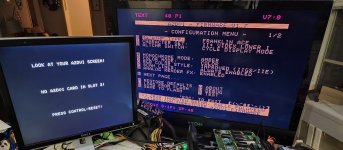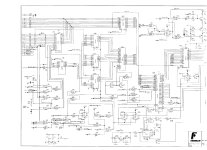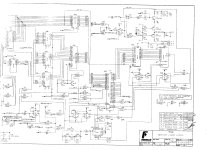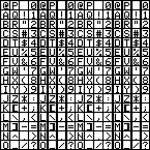Hello all, I am running a stock Franklin Ace 1200 with the included dual interface (PR1 & PR2 virtual), 80-column (PR3), Z80 CPU (PR4) and floppy drive card (PR6) and all appear to be functioning normally.
I've verified the following functionality:
- 40 column mode without any installed cards
- 80 column mode in and out of CP/M
- Reading from sdisk2, formatting/reading/writing physical disks
- Was able to boot the ProDOS loader image from ADTPro through the dual-interface card (ADTPro itself would only give a black screen)
- a2dvi is accessible from the configuration tool, I can change fonts, colors, modes et cetra.
I have primarily used the a2dvi card though out my testing and it's worked wonderfully in 40 column mode. The issue I'm running into is I don't know how to get it to switch to 80-column mode. I can view 80-column mode through the analog video and continue to use the Franklin in analog mode but once PR#3 is ran the a2dvi stops responding; I assume this is because the computer is now writing to a different part of memory for display output. Is there a work around or modification to be made? Or, did I miss a configuration change? I do have VIDEX mode enabled, II+ US and VIDEX low character set selected.
V/R,
Kiser
Edit to add: I've used the a2dvi in PR2, it is currently in PR7 as to not conflict with the virtual serial port.
I've verified the following functionality:
- 40 column mode without any installed cards
- 80 column mode in and out of CP/M
- Reading from sdisk2, formatting/reading/writing physical disks
- Was able to boot the ProDOS loader image from ADTPro through the dual-interface card (ADTPro itself would only give a black screen)
- a2dvi is accessible from the configuration tool, I can change fonts, colors, modes et cetra.
I have primarily used the a2dvi card though out my testing and it's worked wonderfully in 40 column mode. The issue I'm running into is I don't know how to get it to switch to 80-column mode. I can view 80-column mode through the analog video and continue to use the Franklin in analog mode but once PR#3 is ran the a2dvi stops responding; I assume this is because the computer is now writing to a different part of memory for display output. Is there a work around or modification to be made? Or, did I miss a configuration change? I do have VIDEX mode enabled, II+ US and VIDEX low character set selected.
V/R,
Kiser
Edit to add: I've used the a2dvi in PR2, it is currently in PR7 as to not conflict with the virtual serial port.









